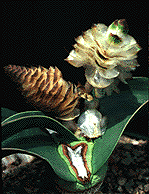Gnetales



This tree diagram shows the relationships between several groups of organisms.
The root of the current tree connects the organisms featured in this tree to their containing group and the rest of the Tree of Life. The basal branching point in the tree represents the ancestor of the other groups in the tree. This ancestor diversified over time into several descendent subgroups, which are represented as internal nodes and terminal taxa to the right.

You can click on the root to travel down the Tree of Life all the way to the root of all Life, and you can click on the names of descendent subgroups to travel up the Tree of Life all the way to individual species.
For more information on ToL tree formatting, please see Interpreting the Tree or Classification. To learn more about phylogenetic trees, please visit our Phylogenetic Biology pages.
close boxReferences
Bustard, L. 1990. The ugliest plant of the world: the story of Welwitschia mirabilis. Kew Magazine. 7:85-90.
Carlquist, S. 1996. Wood, bark, and stem anatomy of Gnetales: A summary. International Journal of Plant Sciences157(6, Suppl.): S58-S76.
Crane, P. R. 1996. The fossil history of the Gnetales. International Journal of Plant Sciences157(6, Suppl.): S50-S57.
Crane, P. R., and S. Lidgard. 1989. Angiosperm diversification and paleolatitudinal gradients in Cretaceous floristic diversity. Science 246:675-678.
Crane, P. R., and G. R. Upchurch Jr. 1987. Drewria potomacensis gen. et sp. nov., an Early Cretaceous member of Gnetales from the Potomac Group of Virginia. Am. J. Bot. 74:1722-1736.
Dilcher, D. L., M. E. Bernardes-De-Oliveira, D. Pons, and T. A. Lott. 2005. Welwitschiaceae from the Lower Cretaceous of northeastern Brazil. American Journal of Botany 92:1294-1310.
Donoghue, M. J. 1989. Phylogenies and the analysis of evolutionary sequences, with examples from seed plants. Evolution 43:1137-1156.
Donoghue, M. J. 1994. Progress and prospects in reconstructing plant phylogeny. Ann. Missouri Bot. Gard. 81:405-418.
Donoghue, M.J. and S.M. Scheiner. 1992. The evolution of endosperm: a phylogenetic account. In Ecology and Evolution of Plant Reproduction: New Approaches, pp.356-389; R. Wyatt (ed.). New York: Chapman and Hall.
Doyle, J. A. 1996. Seed plant phylogeny and the relationships of Gnetales. International Journal of Plant Sciences157(6, Suppl.): S3-S39.
Doyle, J. A., and M. J. Donoghue. 1986. Seed plant phylogeny and the origin of angiosperms: An experimental cladistic approach. Bot. Rev. 52:321-431.
Doyle, J. A., and M. J. Donoghue. 1992. Fossils and seed plant phylogeny reanalyzed. Brittonia 44:89-106.
Endress, P. K. 1996. Structure and function of female and bisexual organ complexes in Gnetales. International Journal of Plant Sciences157(6, Suppl.): S113-S125.
Friedman, W. E. 1990. Double fertilization in Ephedra, a nonflowering seed plant: Its bearing on the origin of angiosperms. Science 247:951-954.
Friedman, W. E. 1992. Evidence of a pre-angiosperm origin of endosperm: Implications for the evolution of flowering plants. Science 225:336-339.
Friedman, W. E. 1994. The evolution of embryogeny in seed plants and the developmenal origin and early history of endosperm. Am. J. Bot. 81:109:153-226.
Friedman, W. E. 1996. Introduction to biology and evolution of the Gnetales. International Journal of Plant Sciences157(6, Suppl.): S1-S2.
Friedman, W. E. and J. S. Carmichael. 1996. Double fertilization in Gnetales: Implications for understanding reproductive diversification among seed plants. International Journal of Plant Sciences157(6, Suppl.): S77-S94.
Hufford, L. 1996. The morphology and evolution of male reproductive structures of Gnetales. International Journal of Plant Sciences157(6, Suppl.): S95-S112.
Hult, C. D. and P. R. Crane. 1988. The Gnetales: botanical remnants from the age of dinosaurs. Field Mus. Nat. Hist. Bull. 59:21-29.
Jacobson K. M., and E. Lester. 2003. A first assessment of genetic variation in Welwitschia mirabilis Hook. Journal of Heredity 94:212-217.
Martens, P. 1971. Les Gnetophytes (Handbuch der Pflanzenanatomie, Band 12, Teil 2). Gebrueder Borntraeger, Berlin.
Meeuse, A. D. J. 1986. Again: Double fertilization and the mono- versus pleiophyletic evolution of angiosperms. Phytomorphology 36:17-21.
Mundry, M. and T. Stutzel. 2004. Morphogenesis of the reproductive shoots of Welwitschia mirabilis and Ephedra distachya (Gnetales), and its evolutionary implications. Organisms Diversity & Evolution 4(1-2):91-108.
Osborn J. M., T. N. Taylor, and M. R. Lima. 1993. The ultrastructure of fossil ephedroid pollen with gnetalean affinities from the Lower Cretaceous of Brazil. Review of Paleobotany and Palynology 77:171-184.
Price, R. A. 1996. Systematics of the Gnetales: a review of morphological and molecular evidence. International Journal of Plant Sciences157(6, Suppl.): S40-S49.
Rydin C., B. Mohr, and E. M. Friis 2003. Cratonia cotyledon gen. et sp. nov.: a unique Cretaceous seedling related to Welwitschia. Proceedings of the Royal Society of London B, Biology Letters (Supplement) 270:1?4.
About This Page
Correspondence regarding this page should be directed to Michael Donoghue at
Page copyright © 1996 Michael J. Donoghue
All Rights Reserved.
Citing this page:
Tree of Life Web Project. 1996. Gnetales. Version 01 January 1996 (temporary). http://tolweb.org/Gnetales/20645/1996.01.01 in The Tree of Life Web Project, http://tolweb.org/













 Go to quick links
Go to quick search
Go to navigation for this section of the ToL site
Go to detailed links for the ToL site
Go to quick links
Go to quick search
Go to navigation for this section of the ToL site
Go to detailed links for the ToL site